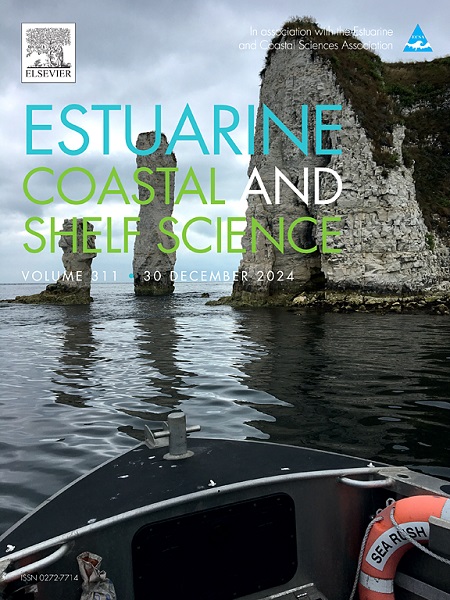In-situ artificial shading improves effective quantum yield and coral color of the tropical corals Acropora muricata and Porites lutea
IF 2.6
3区 地球科学
Q1 MARINE & FRESHWATER BIOLOGY
引用次数: 0
Abstract
Declines in coral reefs areas are commonly attributed to thermal stress-induced coral bleaching. Previous observations have noted that coral reefs bleached less during heat stress in low-light conditions, such as higher turbidity or cloud cover. Artificial shading has been proposed as an adaptive strategy to mitigate the deleterious effects of coral bleaching and improve coral resistance to stressors. However, the widespread application of this method requires more in-depth studies to investigate the effects of shading on coral health. This study implemented 80% artificial shading in-situ on two common species of Indo-Pacific corals at Pulau Rawa, Johor, Malaysia. Acropora muricata and Porites lutea fragments were collected to study the effect of lowered light on effective quantum yield (ΔF/Fm'; 21 days), coral health scores (color saturation; 30 days), and linear growth (A. muricata only; 30 days). Shading significantly increased effective quantum yield in both species by 3.6% and 4.5% in A. muricata and P. lutea on Day 21, respectively. Although the increment is lower, A. muricata achieved higher effective quantum yields than P. lutea in both shaded and control treatments. Implementation of shading had also enhanced the coral health scores in P. lutea by 29.3% on Day 30 compared to their non-shaded counterparts. The growth of A. muricata was not significantly affected by shading during the study period, though shaded corals displayed slightly less growth than non-shaded corals. Artificial shading was shown to have beneficial effects on coral photosynthesis and health during non-bleaching periods. This study lends further credence to artificial shading being used as a mitigation tool for future coral bleaching events, as photosynthetic efficiency and color are indicators of coral bleaching resistance. However, prolonged lowered light conditions may reduce photosynthetic output quantity and result in possibly slower growth rates. This tradeoff between factors of resistance and the different responses to shading in the two species studied implies the need for pilot studies before shading implementation. Further research should consider the short-term and long-term effects of shading removal and possible effects on coral adapted to different light environments before shading can be broadly used.
原位人工遮荫提高了热带珊瑚Acropora muricata和Porites lutea的有效量子产量和珊瑚色
珊瑚礁面积的减少通常归因于热应力引起的珊瑚白化。先前的观察已经注意到,在低光条件下,如浊度高或云量大的情况下,珊瑚礁在热应力下的白化程度较低。人工遮阳已被提出作为一种适应性策略,以减轻珊瑚白化的有害影响,提高珊瑚对压力源的抵抗力。然而,这种方法的广泛应用需要更深入的研究来调查遮阳对珊瑚健康的影响。本研究在马来西亚柔佛州拉瓦岛对两种常见的印度洋-太平洋珊瑚进行了80%的人工遮阳。收集鹿角藻(Acropora muricata)和鹿角藻(Porites lutea)碎片,研究弱光对有效量子产率的影响(ΔF/Fm’;21天),珊瑚健康评分(色彩饱和度;30天),以及线性生长(仅muricata;30天)。遮荫在第21天显著提高了muricata和P. lutea的有效量子产率,分别提高了3.6%和4.5%。在遮荫和对照处理下,村柳的有效量子产率均高于黄杨。与未遮荫的珊瑚相比,遮荫的实施也使P. lutea的珊瑚健康评分在第30天提高了29.3%。在研究期间,遮荫珊瑚的生长没有受到显著影响,但遮荫珊瑚的生长略低于无遮荫珊瑚。在非白化期,人工遮阳对珊瑚的光合作用和健康有有益的影响。由于光合效率和颜色是珊瑚抗白化的指标,这项研究进一步证明了人工遮阳可以作为未来珊瑚白化事件的缓解工具。然而,长时间的弱光条件可能会减少光合产量,并可能导致生长速度减慢。这种权衡因素之间的阻力和不同的反应遮阳在两个物种的研究意味着需要遮阳实施前试点研究。进一步的研究应考虑去除遮阳的短期和长期影响,以及对适应不同光环境的珊瑚可能产生的影响,然后才能广泛应用遮阳。
本文章由计算机程序翻译,如有差异,请以英文原文为准。
求助全文
约1分钟内获得全文
求助全文
来源期刊
CiteScore
5.60
自引率
7.10%
发文量
374
审稿时长
9 months
期刊介绍:
Estuarine, Coastal and Shelf Science is an international multidisciplinary journal devoted to the analysis of saline water phenomena ranging from the outer edge of the continental shelf to the upper limits of the tidal zone. The journal provides a unique forum, unifying the multidisciplinary approaches to the study of the oceanography of estuaries, coastal zones, and continental shelf seas. It features original research papers, review papers and short communications treating such disciplines as zoology, botany, geology, sedimentology, physical oceanography.

 求助内容:
求助内容: 应助结果提醒方式:
应助结果提醒方式:


